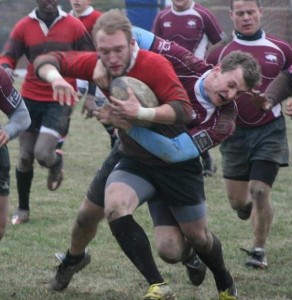 |
| Figure 1. Me removing a ball from a ruck. Photo: Kristen Walsh |
I am a Rhetorical Communications major and Sports Studies and Exercise Science minor and the president of the Rugby Club, and I’d like to tell you about Rugby. If you have ever seen the movie Invictus, starring Morgan Freeman as Nelson Mandela, you may know a little bit already.
There are two types. Rugby Union and Rugby League. Union is the most common and generally what you will see. In Rugby Union, each team is allotted 15 men on the field and only 7 substitutes for the whole 80 minute game.
This is counting injuries. If you have to come off the field because you’re injured, it costs your team a substitution.
Next fall, I will be a junior at St. Lawrence University. I am a Rhetorical Communications major and Sports Studies and Exercise Science minor and the president of the Rugby Club. This summer, I was selected to be a Stan Macdonald intern at North Country Public Radio.
Many say that rugby is the perfect combination of soccer and football. Take the endurance needed to play an 80 minute soccer game, where you are constantly on the move. Then, add the constant physical contact of football. Oh, and we don’t wear pads. What you see on my head in Figure 1. is a scrum cap. Some rugby players (ruggers) wear these to protect their ears and heads, especially forwards. At the forward position, there is a higher chance for your ears to be damaged or for your head to be cleated. A lot of ruggers use metal cleats.
 |
| Figure 2. SLU Dead Cats lining up for a scrum against the Cortland Herd. Photo: Kristen Walsh |
 |
| Figure 3. Back Erik Miller running hard through a high tackle. Photo: Kristen Walsh |
Rugby is the perfect game for the best of both the soccer and football worlds. If you have any questions about Rugby rules, regulations, or about our club, feel free to comment or send an email to me, jlcame11@stlawu.edu. Most importantly, support your local rugby clubs!
Rugby is on the rise in the United States. I know it's not the most popular American sport, but it's become my passion.
 |
| Figure 4. The newly formed St. Lawrence University Rugby Club. Photo: Kristen Walsh |
For a basic explanation of the rules of rugby and more detailed explanation of terms, check out this great instructional video.
https://www.youtube.com/watch?v=IEQyCcageGg
No comments:
Post a Comment